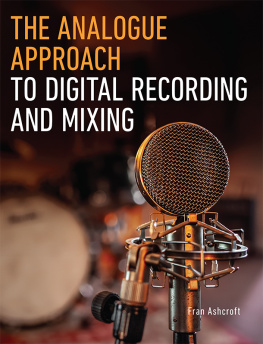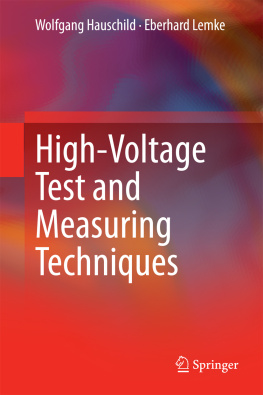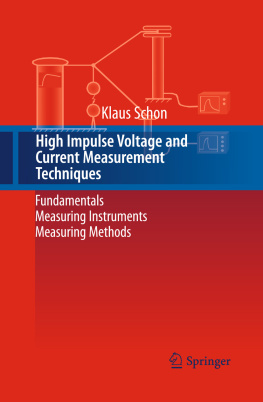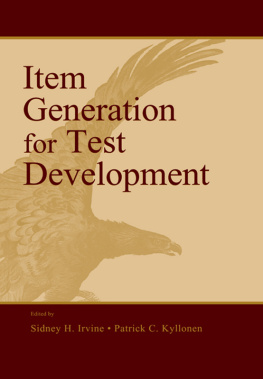Poole - A Guide to Digital & Analogue Multimeters
Here you can read online Poole - A Guide to Digital & Analogue Multimeters full text of the book (entire story) in english for free. Download pdf and epub, get meaning, cover and reviews about this ebook. year: 2015, publisher: Adrio Communications Ltd, genre: Children. Description of the work, (preface) as well as reviews are available. Best literature library LitArk.com created for fans of good reading and offers a wide selection of genres:
Romance novel
Science fiction
Adventure
Detective
Science
History
Home and family
Prose
Art
Politics
Computer
Non-fiction
Religion
Business
Children
Humor
Choose a favorite category and find really read worthwhile books. Enjoy immersion in the world of imagination, feel the emotions of the characters or learn something new for yourself, make an fascinating discovery.
A Guide to Digital & Analogue Multimeters: summary, description and annotation
We offer to read an annotation, description, summary or preface (depends on what the author of the book "A Guide to Digital & Analogue Multimeters" wrote himself). If you haven't found the necessary information about the book — write in the comments, we will try to find it.
Poole: author's other books
Who wrote A Guide to Digital & Analogue Multimeters? Find out the surname, the name of the author of the book and a list of all author's works by series.
A Guide to Digital & Analogue Multimeters — read online for free the complete book (whole text) full work
Below is the text of the book, divided by pages. System saving the place of the last page read, allows you to conveniently read the book "A Guide to Digital & Analogue Multimeters" online for free, without having to search again every time where you left off. Put a bookmark, and you can go to the page where you finished reading at any time.
Font size:
Interval:
Bookmark:
A Guide To
Digital & Analogue Multimeters
By Ian Poole
Copyright Ian Poole
Find More Invaluable Information at
Radio-Electronics.com
The multimeter has been available in a variety of forms for very many years. It forms the mainstay of many test workshops and development laboratories. Measuring the basic quantities of voltage (AC & DC), current (AC & DC) and resistance the multimeter is able to make the main measurements required for many tests.
Nowadays with integrated circuit technology digital multimeters are able to make many more types of measurement from capacitance and inductance to frequency, time, temperature and much more.
In order to make the best use of the multimeter, it is necessary to know how one works and what its limitations are. In this way, it is possible to utilise it more effectively, and in ways that are able to extend its use.
This book aims to provide an approachable grounding into both analogue and digital multimeter technology, explaining how these instruments work,, what their specifications mean, their limitations, and most important of all how to use them. Some tricks of the trade are also revealed, enabling the reader to use these instruments in many new, interesting and useful ways.
The multimeter is an instrument that has been in use for many decades and they are widely used today as much as ever. They have found considerable use because they are easily able to make many of the basic measurements required in all forms of electrical and electronic testing.
Today, it is possible to buy a multimeter with a high level of performance for a relatively low sum. Having moved from analogue meters where precision meters and components were required, to digital instruments where many of the functions can be accurately incorporated into integrated circuits, these instruments are often cheaper to make. Also, their widespread use means that they are manufactured in large quantities enabling the savings of scale to be made.
Multimeters have been available for many years. Over the years the technologies used in them have changed, taking them from large expensive instruments to the portable accurate items they are today.
In the very early days when the first experiments were being made into the conduction of electrical currents, one of the main challenges that held back development was the ability to measure the current.
Only when it was realised that a current passing through a conductor created a magnetic field could any form of measuring device be made.
It was not until 1820 that the first basic galvanometer was made. These instruments were used within a Wheatstone bridge and were able to detect null points and as a result they could measure resistance and voltage. However these bridges were slow and cumbersome to use.
The next development was that of a meter with a fine coiled spring that enabled proportional measurements to be made. Using fixed magnets and a current carrying coil the deflection of the meter pointer was proportional to the current being passed and hence these instruments could be calibrated. Known as the D'Arsonval/Weston meter these instruments enabled direct measurements to be made. Also by adding a series or shunt resistor the meter was able to measure voltage and current over several ranges.
The next step was to combine the capability of making several different measurements into one instrument. The concept of the first analogue multimeter was born when an engineer working for the British Post Office who dealt with the telecommunications infrastructure in the UK became dissatisfied with having to use several instruments to measure voltage, current and resistance.
The engineer, named MacAdie developed an idea for a multifunctional instrument and took it to a small company named the Automatic Coil Winder and Electrical Equipment Company. The instrument was converted from a concept into a real instrument and named the AVO; standing for Amps, Volts and Ohms.
The first instrument, which as a DC only instrument was launched in 1923, but contained many of the features which were maintained in the AVO right up until the last analogue AVOs were sold in June 2008. At this time it was reputed to be the last professional analogue multimeter being manufactured in the world, making it the first and last.
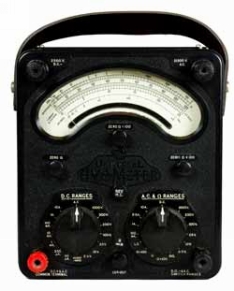
An AVO 8 Mk III
The success of the AVO meant that many other companies designed and developed their own versions of the AVO. They became so widely used that the generic name multimeter was adopted although some used names such as VOA standing for Volts, Amps and Ohms or VOM standing for Volt Ohm Meter.
The analogue multimeters came in a variety of form factors from small and often very cheap instruments right up to robust professional instruments such as the AVO.
One of the drawbacks of the analogue multimeter was that it needed to draw a finite current for the meter to operate and the needle or pointer to deflect. This gave rise to a class of instruments that used valve or vacuum tubes to provide a much higher input level. These meters using valve / vacuum tube technology were known as either Vacuum Tube Voltmeters, VTVM, or Valve Voltmeters, VTM. Using the very high input impedance of the valve / vacuum tube they were able to provide very high levels of input impedance - levels of 1 M.
Later as semiconductor technology became more widespread, transistors and in particular FETs were used to provide similar capabilities.
Technology proceeded still further as integrated circuit technology allowed for high levels of integration to be achieved. A different approach was adopted, converting the voltage into a digital format which could be processed and then displayed. These digital multimeters, DMMs became very popular, often falling in price below that of their analogue counterparts.
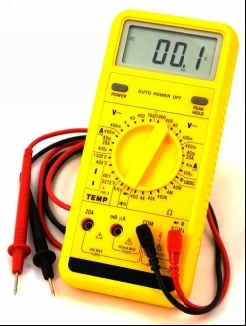
A typical Digital Multimeter
The use of digital technology enabled far more functionality to be incorporated in these test meters. Additional scales like decibels and True RMS could be used as well as including new measurement functions. DMMs with capabilities including capacitance, transistor gain, frequency, duty cycle, temperature (with the use of an external thermocouple, inductance, display hold, and buzzers which sound continuity measurements.
All these developments have considerably improved the functionality of these instruments increasing the number of measurements that can be made and making them truly multi-meters.
Although some analogue multimeters can still be bought, the majority of meters sold and used today are digital types. These digital multimeters or DMMs can be obtained cheaply, although more robust and higher specification models obviously cost more. DMMs are not only easy to use but they also provide a very high level of performance and accuracy for their cost.
The analog or analogue multimeter has been one of the mainstays used for electronics test.
Although digital multimeters have become the option of choice these days as their costs have fallen and they are still used in some areas because they are extremely flexible and can be used to locate faults, and be used for general electrical and electronic measurements in many areas.
Next pageFont size:
Interval:
Bookmark:
Similar books «A Guide to Digital & Analogue Multimeters»
Look at similar books to A Guide to Digital & Analogue Multimeters. We have selected literature similar in name and meaning in the hope of providing readers with more options to find new, interesting, not yet read works.
Discussion, reviews of the book A Guide to Digital & Analogue Multimeters and just readers' own opinions. Leave your comments, write what you think about the work, its meaning or the main characters. Specify what exactly you liked and what you didn't like, and why you think so.







